Abstract
1. The relationship between plasma and brain caffeine and metabolite concentrations and behavioural stimulation was investigated over a 4 h time course. 2. CD-1 mice receiving single intraperitoneal doses of caffeine-sodium benzoate solution (caffeine doses: 0, 20, and 40 mg kg-1) were evaluated in an activity monitor, and their plasma and brain caffeine and metabolite concentrations were determined by high performance liquid chromatography (h.p.l.c.). 3. Kinetic variables for caffeine at low and high caffeine doses were: volume of distribution (Vd), 1.16 and 0.88 l kg-1; plasma elimination half-life (t1/2), 1.25 and 1.62 h; brain t1/2, 0.93 and 1.30 h; clearance, 0.64 and 0.38 l h-1 kg-1, respectively, with Vd and brain t1/2 differing significantly between the two caffeine doses. 4. Low-dose caffeine stimulated vertical behaviours significantly more than high-dose, during the first 150 min post-dosage; both doses stimulated vertical behaviours significantly more than vehicle treatment. 5. Low-dose and high-dose caffeine stimulated horizontal and stereotypic behaviours equivalently, during the first 150 min post-dosage; both doses stimulated these behaviours significantly more than vehicle. 6. Only later, 150 min post-dosage, did high-dose caffeine stimulate all behaviours significantly more than both low-dose and vehicle treatment; this occurred when caffeine concentrations had fallen to approximately 10 micrograms g-1 in the high-dose group. 7. The maximal stimulant effects of caffeine occurred in an intermediate concentration range, between 10-20 micrograms g-1, while lower and higher concentrations produced either no additional stimulation or decrements in activity.
Full text
PDF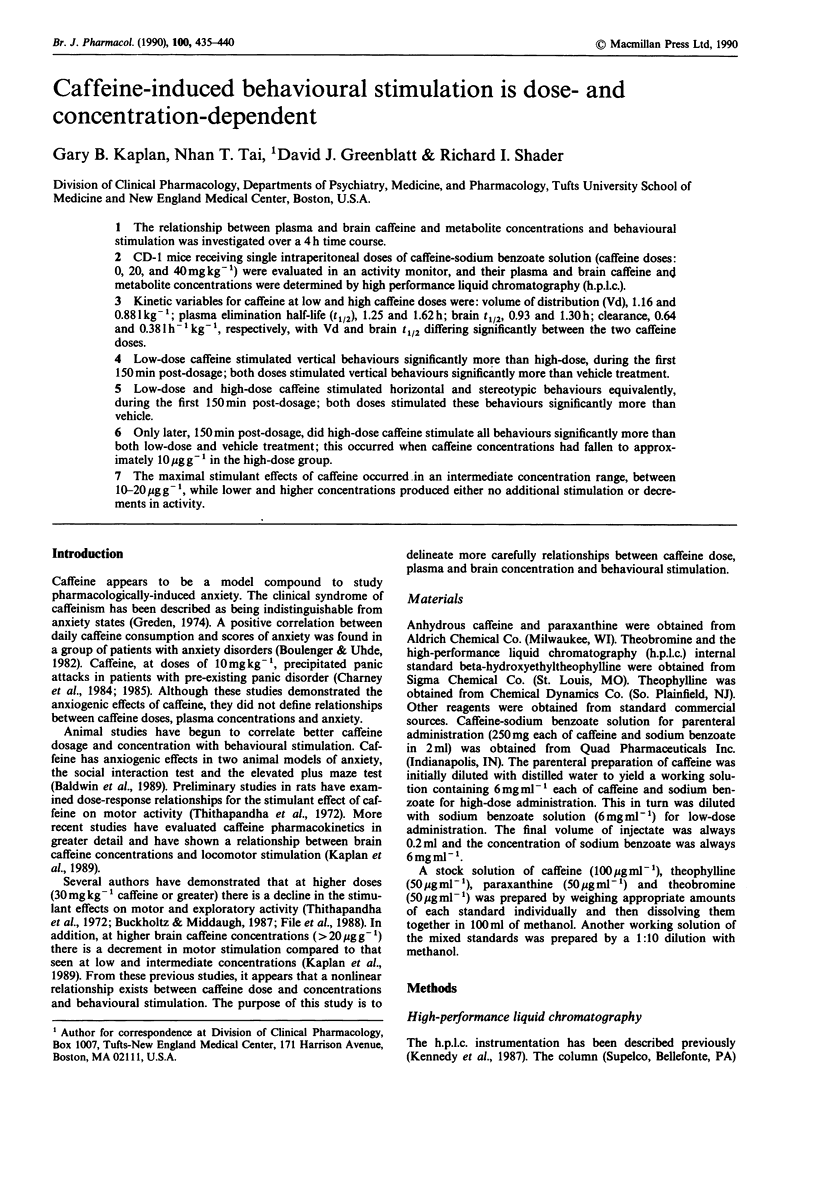
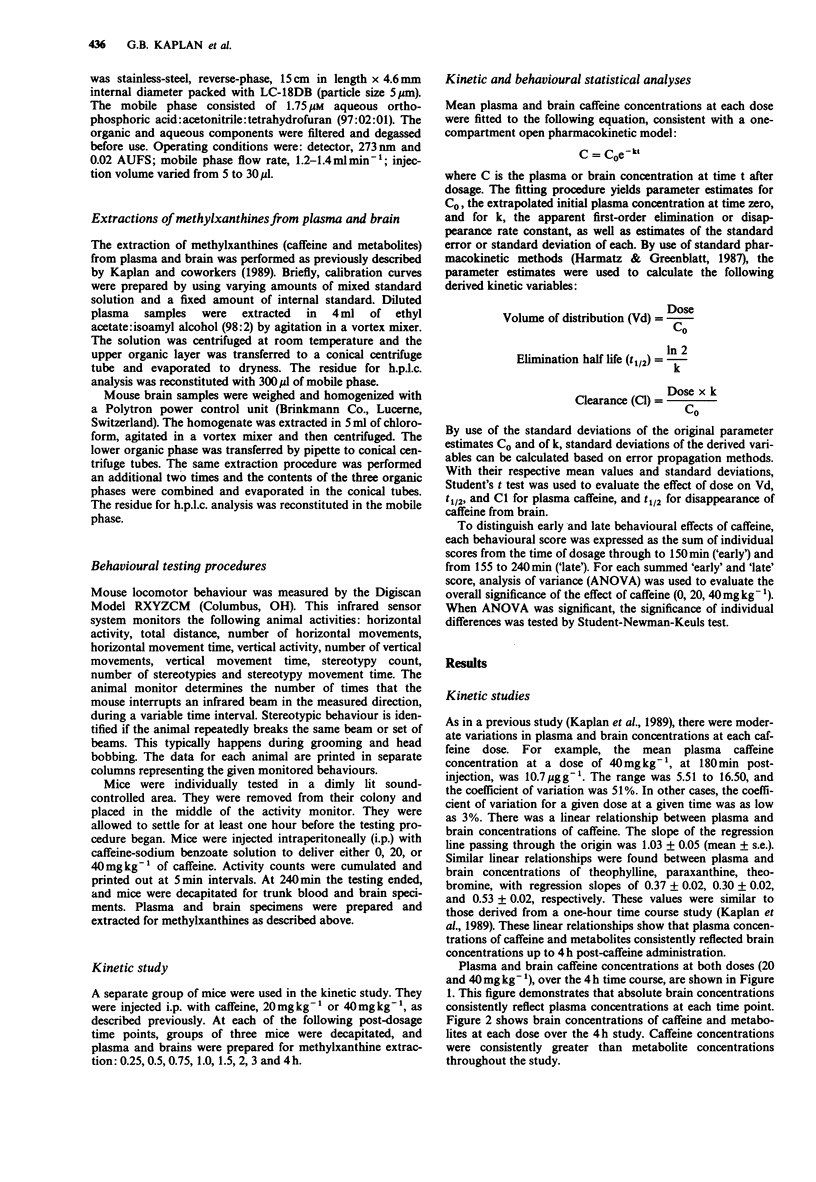
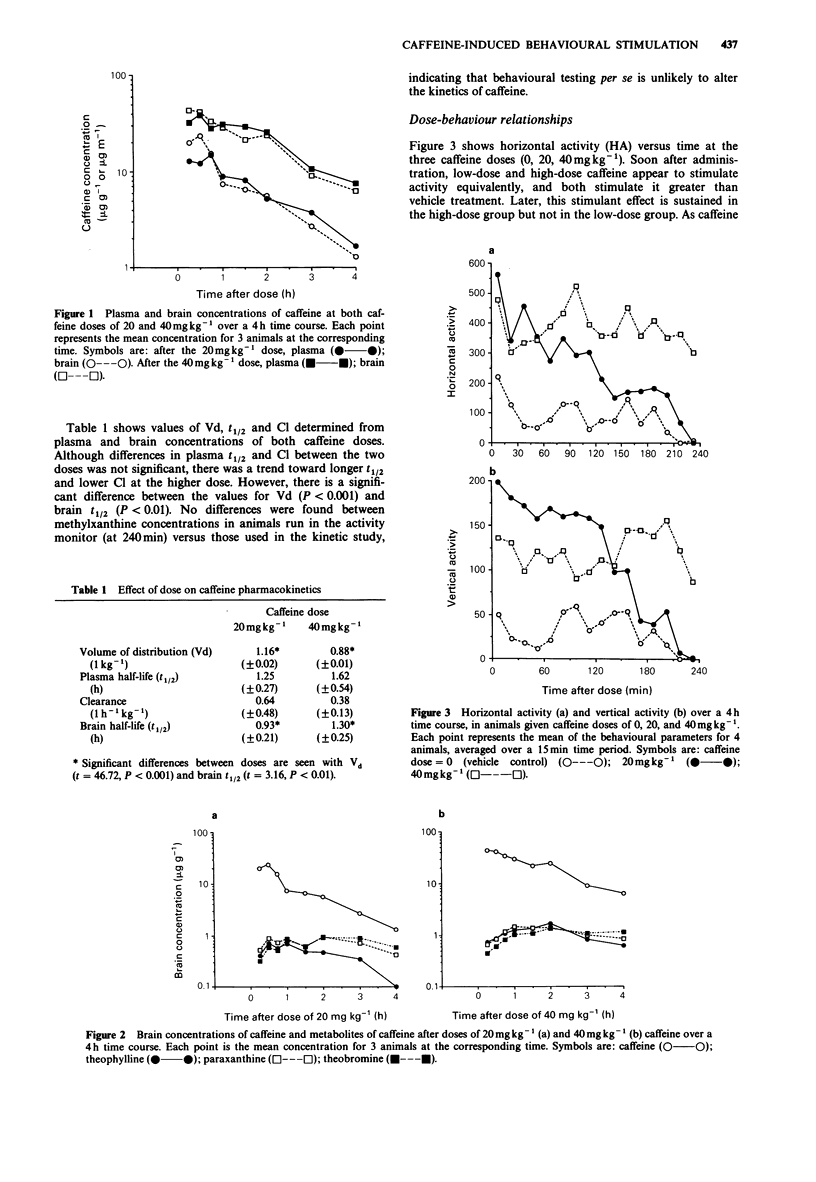
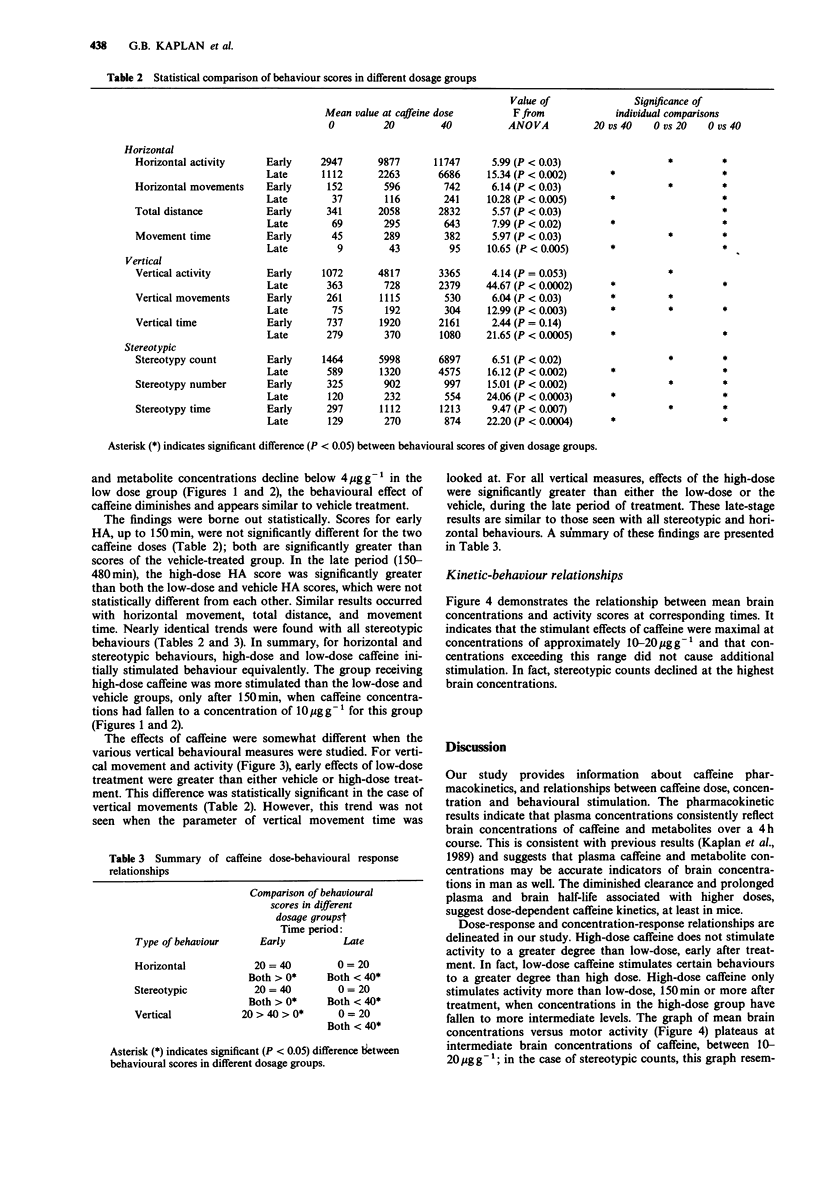
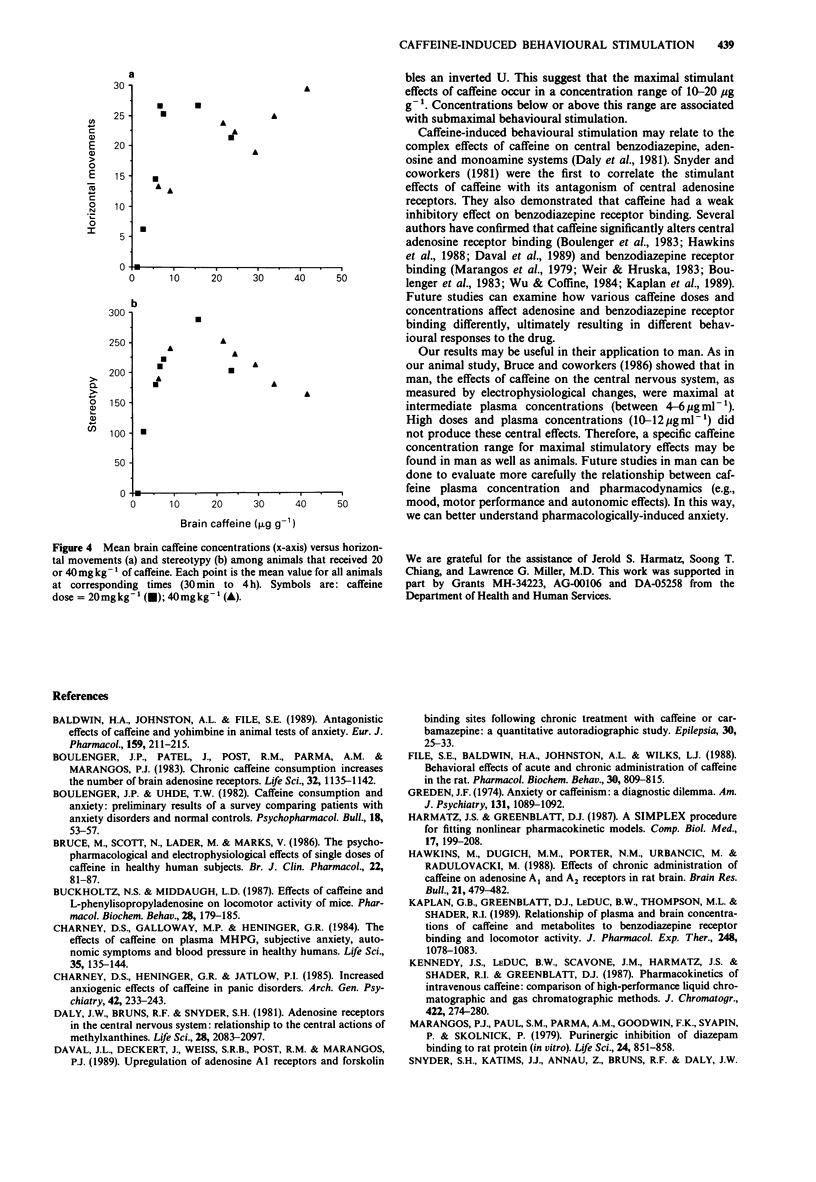
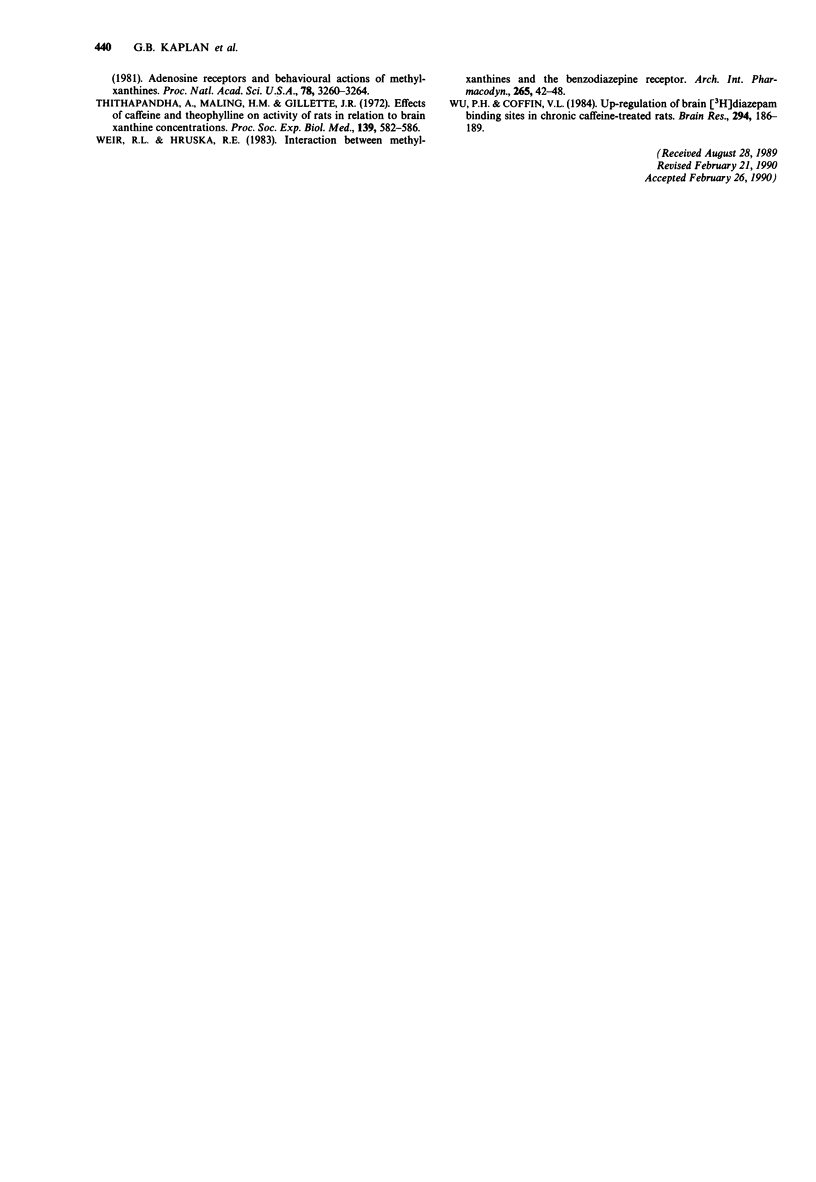
Selected References
These references are in PubMed. This may not be the complete list of references from this article.
- Baldwin H. A., Johnston A. L., File S. E. Antagonistic effects of caffeine and yohimbine in animal tests of anxiety. Eur J Pharmacol. 1989 Jan 10;159(2):211–215. doi: 10.1016/0014-2999(89)90709-7. [DOI] [PubMed] [Google Scholar]
- Boulenger J. P., Patel J., Post R. M., Parma A. M., Marangos P. J. Chronic caffeine consumption increases the number of brain adenosine receptors. Life Sci. 1983 Mar 7;32(10):1135–1142. doi: 10.1016/0024-3205(83)90119-4. [DOI] [PubMed] [Google Scholar]
- Boulenger J. P., Uhde T. W. Caffeine consumption and anxiety: preliminary results of a survey comparing patients with anxiety disorders and normal controls. Psychopharmacol Bull. 1982 Oct;18(4):53–57. [PubMed] [Google Scholar]
- Bruce M., Scott N., Lader M., Marks V. The psychopharmacological and electrophysiological effects of single doses of caffeine in healthy human subjects. Br J Clin Pharmacol. 1986 Jul;22(1):81–87. doi: 10.1111/j.1365-2125.1986.tb02883.x. [DOI] [PMC free article] [PubMed] [Google Scholar]
- Buckholtz N. S., Middaugh L. D. Effects of caffeine and L-phenylisopropyladenosine on locomotor activity of mice. Pharmacol Biochem Behav. 1987 Oct;28(2):179–185. doi: 10.1016/0091-3057(87)90211-5. [DOI] [PubMed] [Google Scholar]
- Charney D. S., Galloway M. P., Heninger G. R. The effects of caffeine on plasma MHPG, subjective anxiety, autonomic symptoms and blood pressure in healthy humans. Life Sci. 1984 Jul 9;35(2):135–144. doi: 10.1016/0024-3205(84)90132-2. [DOI] [PubMed] [Google Scholar]
- Charney D. S., Heninger G. R., Jatlow P. I. Increased anxiogenic effects of caffeine in panic disorders. Arch Gen Psychiatry. 1985 Mar;42(3):233–243. doi: 10.1001/archpsyc.1985.01790260027003. [DOI] [PubMed] [Google Scholar]
- Daly J. W., Bruns R. F., Snyder S. H. Adenosine receptors in the central nervous system: relationship to the central actions of methylxanthines. Life Sci. 1981 May 11;28(19):2083–2097. doi: 10.1016/0024-3205(81)90614-7. [DOI] [PubMed] [Google Scholar]
- Daval J. L., Deckert J., Weiss S. R., Post R. M., Marangos P. J. Upregulation of adenosine A1 receptors and forskolin binding sites following chronic treatment with caffeine or carbamazepine: a quantitative autoradiographic study. Epilepsia. 1989 Jan-Feb;30(1):26–33. doi: 10.1111/j.1528-1157.1989.tb05276.x. [DOI] [PubMed] [Google Scholar]
- File S. E., Baldwin H. A., Johnston A. L., Wilks L. J. Behavioral effects of acute and chronic administration of caffeine in the rat. Pharmacol Biochem Behav. 1988 Aug;30(4):809–815. doi: 10.1016/0091-3057(88)90104-9. [DOI] [PubMed] [Google Scholar]
- Greden J. F. Anxiety or caffeinism: a diagnostic dilemma. Am J Psychiatry. 1974 Oct;131(10):1089–1092. doi: 10.1176/ajp.131.10.1089. [DOI] [PubMed] [Google Scholar]
- Harmatz J. S., Greenblatt D. J. A simplex procedure for fitting nonlinear pharmacokinetic models. Comput Biol Med. 1987;17(3):199–208. doi: 10.1016/0010-4825(87)90044-8. [DOI] [PubMed] [Google Scholar]
- Hawkins M., Dugich M. M., Porter N. M., Urbancic M., Radulovacki M. Effects of chronic administration of caffeine on adenosine A1 and A2 receptors in rat brain. Brain Res Bull. 1988 Sep;21(3):479–482. doi: 10.1016/0361-9230(88)90162-1. [DOI] [PubMed] [Google Scholar]
- Kaplan G. B., Greenblatt D. J., Leduc B. W., Thompson M. L., Shader R. I. Relationship of plasma and brain concentrations of caffeine and metabolites to benzodiazepine receptor binding and locomotor activity. J Pharmacol Exp Ther. 1989 Mar;248(3):1078–1083. [PubMed] [Google Scholar]
- Kennedy J. S., Leduc B. W., Scavone J. M., Harmatz J. S., Shader R. I., Greenblatt D. J. Pharmacokinetics of intravenous caffeine: comparison of high-performance liquid chromatographic and gas chromatographic methods. J Chromatogr. 1987 Nov 27;422:274–280. doi: 10.1016/0378-4347(87)80463-2. [DOI] [PubMed] [Google Scholar]
- Marangos P. J., Paul S. M., Parma A. M., Goodwin F. K., Syapin P., Skolnick P. Purinergic inhibition of diazepam binding to rat brain (in vitro). Life Sci. 1979 Feb 26;24(9):851–857. doi: 10.1016/0024-3205(79)90369-2. [DOI] [PubMed] [Google Scholar]
- Snyder S. H., Katims J. J., Annau Z., Bruns R. F., Daly J. W. Adenosine receptors and behavioral actions of methylxanthines. Proc Natl Acad Sci U S A. 1981 May;78(5):3260–3264. doi: 10.1073/pnas.78.5.3260. [DOI] [PMC free article] [PubMed] [Google Scholar]
- Thithapandha A., Maling H. M., Gillette J. R. Effects of caffeine and theophylline on activity of rats in relation to brain xanthine concentrations. Proc Soc Exp Biol Med. 1972 Feb;139(2):582–586. doi: 10.3181/00379727-139-36191. [DOI] [PubMed] [Google Scholar]
- Weir R. L., Hruska R. E. Interaction between methylxanthines and the benzodiazepine receptor. Arch Int Pharmacodyn Ther. 1983 Sep;265(1):42–48. [PubMed] [Google Scholar]
- Wu P. H., Coffin V. L. Up-regulation of brain [3H]diazepam binding sites in chronic caffeine-treated rats. Brain Res. 1984 Feb 27;294(1):186–189. doi: 10.1016/0006-8993(84)91329-5. [DOI] [PubMed] [Google Scholar]


